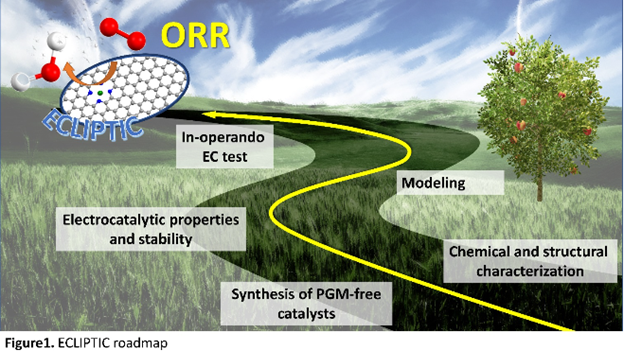PRIN 2022 / Bertani

Acronimo: ECLIPTIC
Titolo: NoblE metals free hierarchical Catalysts and eLectrocatalysts engIneering
Responsabile scientifico: prof.ssa Roberta BERTANI- Dipartimento di Ingegneria Industriale-Università’ degli Studi di PADOVA
Coordinatore: prof.ssa Silvia NAPPINI – Consiglio Nazionale delle Ricerche
Partern-Unità di ricerca: Dipartimento di Ingegneria Industriale-Università degli Studi di PADOVA, Università degli Studi ROMA TRE
Bando: PRIN 2022 - Decreto Direttoriale n. 104 del 02-02-2022
Durata: 28/09/2023 - 27/09/2025 (24 mesi)
Budget totale progetto: € 273.426,00
Abstract del progetto
Renewable energy technologies are gaining attentions due to the problem of the fossil fuels consumption. The oxygen reduction reaction (ORR) is a key reaction in electrochemical technologies of proton exchange membrane fuel cells (PEMFC) and metal-air batteries, which are aimed to reduce the use of fossil fuels, air pollution and greenhouse gas emissions, ensuring highly
efficient energy conversion. The development of low-cost ORR electrocatalysts with enhanced activity and improved durability is decisive for the widespread application of new energy conversion technologies. ECLIPTIC aim is the design, preparation and characterization, also from a theoretical point of view, of new heterogeneous catalysts for oxidation reactions, as ORR active model systems. The catalysts will be based on non-noble metals, as chelated systems or nanoparticles (NPs), supported on N- and P- doped porous carbonaceous substrates, either commercial (Vulcan or Ketjenblack) or suitably prepared (reduced graphene oxide or activated C). The project activities will take place according to the following logical sequence:
1)Preparation of interconnected hierarchical microporous/mesoporous/macroporous N- and P- doped carbonaceous structures with a high specific surface area to simultaneously maximize the efficient utilization of the active sites and facilitating mass transportation. A state-of-the-art strategy for PN co-doping will be carried out with the use of phosphazene systems. Carbonaceous substrates will be prepared under optimized pyrolytic conditions, also from recycled biomasses, in
agreement with a green chemistry approach and circular economy perspective.
2)Incorporation of the metals to optimize the metal dispersion on the substrate overcoming agglomeration and avoiding the formation of inactive oxides/clusters during the synthesis following in situ or ex situ procedures. The influence of the metals on the porosity and graphitization degree will be studied.
3)Investigation of the electronic and morphological structure of the catalysts using ex situ and in-operando approaches. Synchrotron radiation spectroscopies will be employed to unravel chemical composition, nature of the catalytic sites and the electron transfer mechanism at the gas/liquid-solid interface. This approach, supported by first-principle Density functional Theory (DFT) and Molecular Dynamics (MD), will provide a strong link with the real systems, allowing the optimization of the synthesis and the advancement towards improved catalytic performances.
4)Electronic properties testing will be conducted, also by impregnating the catalysts with ionic liquids (ILs) to explore their modulating effect on the H2O vs H2O2 selectivity. As proof of concept, the catalytic activity in two oxidation processes of industrial interest (glyoxal and glycerol oxidations) and the ability of the prepared systems as H2O2 sensors will be tested.
The ECLIPTIC roadmap is shown in Fig.1.






